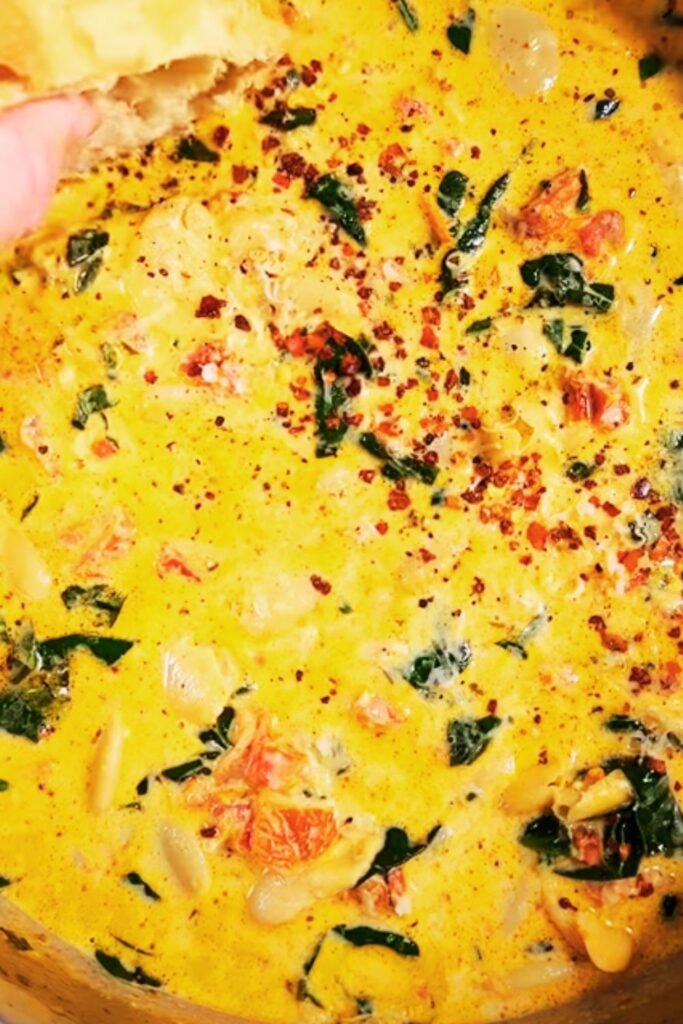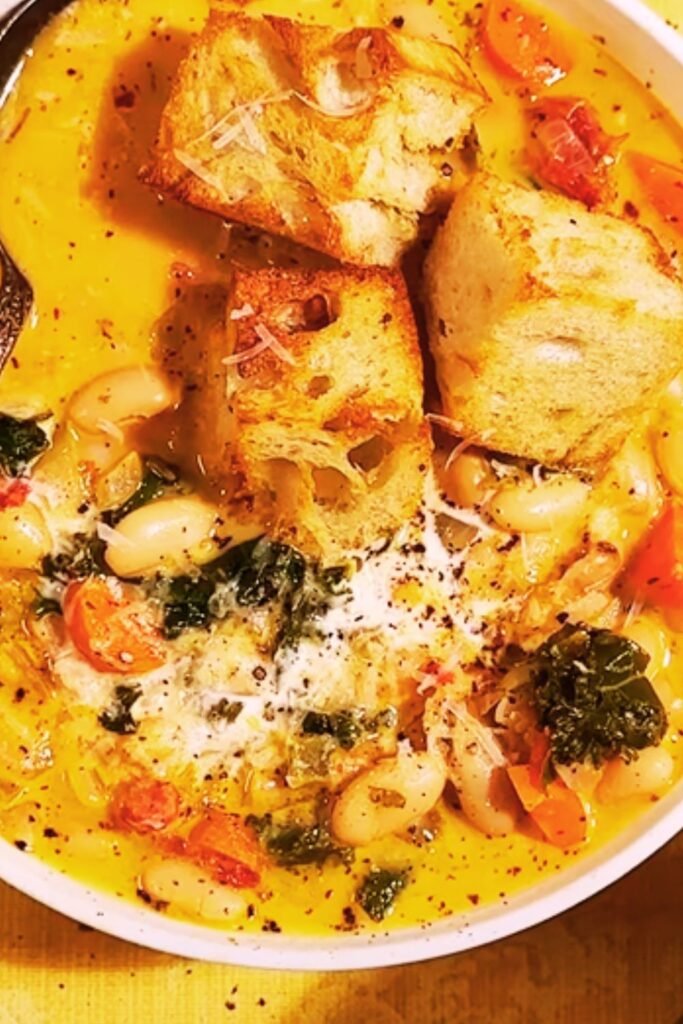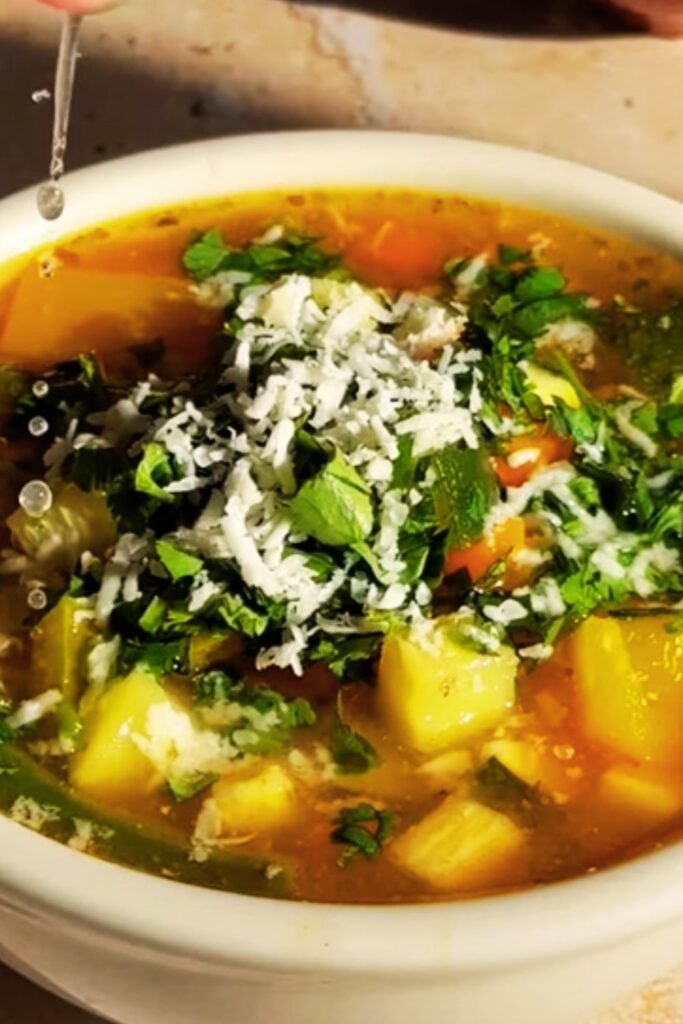There’s a reason this soup earned its romantic nickname. One spoonful of this hearty, herb-infused Tuscan vegetable soup might just inspire a marriage proposal! I’ve been making this comforting dish for years, and it never fails to bring smiles around my dinner table. The rich combination of fresh vegetables, fragrant herbs, and creamy beans creates a satisfying meal that warms both body and soul.
A Love Affair with Tuscan Flavors
My first encounter with authentic Tuscan cuisine happened during a memorable trip to Florence. Wandering through the charming streets, I discovered a small, family-owned trattoria tucked away from the tourist paths. The chef, a warm Italian grandmother type, served me a bowl of vegetable soup that changed my culinary perspective forever. The flavors were so simple yet profound—fresh vegetables, good olive oil, aromatic herbs, and that distinctly Tuscan satisfaction of turning humble ingredients into something extraordinary.
This recipe is my love letter to that experience, adapted for my home kitchen while staying true to the authentic flavors that captured my heart. It balances the rustic simplicity of Tuscan cooking with nourishing ingredients that create a truly satisfying meal.
What Makes This Soup Special
Unlike many vegetable soups that can feel light or insubstantial, this Tuscan version delivers remarkable depth and richness without any meat. Here’s what makes it special:
- Layers of Flavor: Building flavor at each step creates incredible complexity
- Hearty Texture: The combination of vegetables and beans makes it satisfyingly filling
- Nutritional Powerhouse: Packed with vitamins, minerals, fiber, and plant protein
- One-Pot Wonder: Everything comes together in a single pot for easy cleanup
- Better the Next Day: The flavors deepen overnight, making leftovers a delight
Essential Ingredients

The Vegetable Base
- Carrots: 3 medium, diced
- Celery: 3 stalks, diced
- Yellow Onion: 1 large, finely chopped
- Garlic: 4 cloves, minced
- Leek: 1 medium, white and light green parts only, cleaned and sliced
The Heart of the Soup
- Tuscan Kale (Cavolo Nero): 1 bunch, stems removed and roughly chopped
- Zucchini: 2 medium, diced
- Yellow Squash: 1 medium, diced
- Fresh Tomatoes: 4 medium, diced (or 1 can (28 oz) San Marzano tomatoes, crushed)
- Potato: 1 medium russet, peeled and diced
- Cannellini Beans: 2 cans (15 oz each), drained and rinsed
The Flavor Enhancers
- Extra Virgin Olive Oil: 3 tablespoons (plus more for serving)
- Fresh Rosemary: 2 sprigs
- Fresh Thyme: 4 sprigs
- Fresh Sage: 4 leaves, chopped
- Bay Leaves: 2
- Vegetable Broth: 6 cups (homemade preferred)
- Parmesan Rind: 1 piece (optional but highly recommended)
- Sea Salt and Freshly Ground Black Pepper: To taste
- Red Pepper Flakes: Pinch (optional)
For Serving
- Fresh Basil: Roughly torn
- Grated Parmesan Cheese: Freshly grated
- Crusty Bread: Toasted and rubbed with garlic
- Extra Virgin Olive Oil: High-quality, for drizzling
Ingredient Notes and Substitutions
| Ingredient | Why It Matters | Possible Substitutions | Nutritional Benefits |
|---|---|---|---|
| Tuscan Kale | Its robust texture holds up well in soup and provides earthy flavor | Regular kale, Swiss chard, or spinach (add spinach at the end) | High in vitamins A, K, C, calcium, and antioxidants |
| Cannellini Beans | Classic in Tuscan cooking, provides creaminess and protein | Great Northern beans, navy beans, or chickpeas | Excellent source of plant protein, fiber, and minerals |
| Parmesan Rind | Adds incredible umami depth and richness | Pecorino rind or 1 tbsp nutritional yeast | Provides subtle saltiness and complexity |
| Fresh Herbs | Essential for authentic flavor | Dried herbs (use 1/3 the amount of fresh) | Contains essential oils with health benefits |
| San Marzano Tomatoes | Sweeter and less acidic than regular tomatoes | Any high-quality canned tomatoes | Rich in lycopene, vitamin C, and antioxidants |
Kitchen Equipment You’ll Need
- Large Dutch oven or heavy-bottomed soup pot (6-8 quart)
- Sharp chef’s knife
- Cutting board
- Wooden spoon
- Measuring cups and spoons
- Ladle for serving
Step-by-Step Cooking Method
Step 1: Prepare Your Soffritto Base
- Heat 3 tablespoons of olive oil in a large Dutch oven over medium heat.
- Add the diced onion, carrot, celery, and leek along with a pinch of salt.
- Cook slowly for 10-12 minutes, stirring occasionally, until vegetables are softened but not browned. This slow cooking releases the natural sweetness of the vegetables.
- Add the minced garlic and cook for another 1-2 minutes until fragrant.
Step 2: Build the Flavor Foundation
- Tie the rosemary and thyme sprigs with kitchen twine to create an herb bundle (bouquet garni).
- Add the herb bundle, chopped sage, and bay leaves to the pot.
- If using red pepper flakes, add them now.
- Pour in the diced tomatoes with their juices and stir well, scraping any browned bits from the bottom of the pot.
- Cook for 5-7 minutes until the tomatoes begin to break down.
Step 3: Add Remaining Vegetables
- Add the diced potato, zucchini, and yellow squash to the pot and stir to combine.
- Season with 1 teaspoon salt and 1/2 teaspoon freshly ground black pepper.
- Cook for 5 minutes, allowing the vegetables to begin softening.
Step 4: Simmer the Soup
- Add the vegetable broth and Parmesan rind (if using).
- Bring the mixture to a gentle boil, then reduce heat to maintain a simmer.
- Cover partially and cook for 15-20 minutes, until the potato is just tender.
Step 5: Add Beans and Kale
- Add the drained and rinsed cannellini beans to the pot.
- Stir in the chopped Tuscan kale.
- Simmer for another 10-15 minutes until the kale is tender but still maintains some texture.
- Taste and adjust seasoning with additional salt and pepper as needed.
Step 6: Finish and Serve
- Remove the herb bundle, bay leaves, and Parmesan rind.
- Ladle the hot soup into bowls.
- Garnish each serving with torn fresh basil, a drizzle of high-quality olive oil, and freshly grated Parmesan cheese.
- Serve immediately with toasted crusty bread on the side.
Three Critical Success Factors

- Patience with the Soffritto: The slow cooking of onions, carrots, celery, and leeks creates the essential flavor foundation. Don’t rush this step—those 10-12 minutes develop deep, sweet flavors that elevate the entire soup.
- Quality Ingredients Matter: Since this is a simple, vegetable-forward soup, the quality of each component significantly impacts the final flavor. Use the freshest seasonal vegetables you can find and good-quality olive oil for the best results.
- Balanced Seasoning: Taste throughout the cooking process and adjust the seasoning. Remember that Parmesan adds saltiness, so be careful not to over-salt early in the cooking process.
Make-Ahead and Storage Tips
This soup is perfect for meal prep and actually improves with time as the flavors meld together. Here’s how to make the most of it:
Refrigerator Storage
- Store in an airtight container in the refrigerator for up to 4 days.
- The soup will thicken as it sits; add a splash of broth when reheating if needed.
- The flavors actually deepen overnight, making day-two soup even more delicious.
Freezer Storage
- Cool the soup completely before transferring to freezer-safe containers.
- Leave about 1 inch of headspace to allow for expansion.
- Freeze for up to 3 months.
- Thaw overnight in the refrigerator before reheating.
Reheating Instructions
- Stovetop: Reheat gently over medium-low heat, stirring occasionally.
- Microwave: Heat in microwave-safe bowl in 1-minute intervals, stirring between each.
Serving Suggestions

Turn this hearty soup into a complete meal with these perfect pairings:
Bread Options
- Crusty Ciabatta: Toasted and rubbed with a garlic clove
- Rosemary Focaccia: The herb complements the soup beautifully
- Whole Grain Sourdough: For extra nutrition and flavor complexity
Simple Sides
- Mixed Green Salad: With a light lemon vinaigrette
- Roasted Vegetable Platter: Especially good with roasted bell peppers and eggplant
- Caprese Salad: Fresh mozzarella, tomatoes, and basil
Non-Alcoholic Beverage Pairings
- Sparkling Water: With fresh lemon or cucumber
- Iced Tea: With lemon and fresh mint
- Italian Soda: Made with fruit syrup and sparkling water
Nutritional Benefits
This soup isn’t just delicious—it’s also remarkably nutritious! Here’s a breakdown of the health benefits:
| Ingredient | Key Nutrients | Health Benefits |
|---|---|---|
| Kale | Vitamins A, C, K, folate, calcium | Supports bone health, immune function, and antioxidant protection |
| Cannellini Beans | Protein, fiber, iron, potassium | Promotes digestive health, blood sugar regulation, and sustained energy |
| Tomatoes | Lycopene, vitamin C, potassium | Supports heart health and provides antioxidant protection |
| Carrots | Beta-carotene, vitamin K, potassium | Promotes eye health and immune function |
| Olive Oil | Monounsaturated fats, vitamin E | Supports heart health and provides anti-inflammatory benefits |
| Garlic | Allicin, manganese, vitamin B6 | Offers immune support and anti-inflammatory properties |
| Fresh Herbs | Various antioxidants and essential oils | Provides anti-inflammatory and digestive benefits |
One serving (approximately 1.5 cups) provides:
- Calories: Approximately 280
- Protein: 12g
- Fiber: 9g
- Carbohydrates: 42g
- Fat: 8g (primarily healthy fats from olive oil)
Variations to Try
Rustic Tuscan Soup
Add 1 cup of farro or barley during step 4 for a heartier grain-based version. You may need to add extra broth and cooking time.
Spring Tuscan Soup
In springtime, substitute asparagus, peas, and fava beans for some of the vegetables for a lighter, seasonal adaptation.
Creamy Tuscan Soup
Puree half the soup using an immersion blender for a creamier texture while maintaining some chunky vegetables.
Protein-Packed Version
Add 2 cups of shredded rotisserie chicken or 8 ounces of crumbled Italian sausage (browned before adding the vegetables).
Common Mistakes to Avoid
- Cutting vegetables too small: Keep them chunky (about 1/2-inch dice) so they maintain some texture after cooking.
- Adding all vegetables at once: Layering ingredients at different times ensures each cooks properly without some becoming mushy.
- Skipping the sauté steps: Building flavor gradually is key—don’t dump everything in at once.
- Boiling instead of simmering: A gentle simmer preserves vegetable texture and flavor.
- Not using enough salt: Vegetables need proper seasoning to shine; taste and adjust throughout cooking.
Frequently Asked Questions

Q: Can I make this soup in a slow cooker? A: Yes! Sauté the soffritto (onions, carrots, celery, leeks, and garlic) on the stovetop first, then transfer to a slow cooker with remaining ingredients except beans and kale. Cook on low for 6-7 hours, adding beans and kale during the last 30 minutes.
Q: How can I make this recipe vegan? A: Simply omit the Parmesan rind and cheese garnish, or use nutritional yeast for a similar umami flavor. Make sure your vegetable broth is vegan as some commercial brands contain animal products.
Q: I can’t find Tuscan kale. What should I substitute? A: Regular curly kale works great! You can also use Swiss chard or spinach—just add spinach in the last 5 minutes as it cooks much faster.
Q: My soup seems too thick. What should I do? A: Simply add more vegetable broth until you reach your desired consistency. Remember that the soup will continue to thicken as it sits, especially if there are potatoes in it.
Q: Can I use dried herbs instead of fresh? A: Yes, substitute with 1/3 the amount of dried herbs (1 teaspoon dried for 1 tablespoon fresh). Add dried herbs earlier in the cooking process to allow them to hydrate and release their flavors.
Q: How can I add more protein to this soup? A: You can add a third can of beans, include some quinoa, or add cooked chicken or turkey. For vegetarians, a sprinkle of hemp seeds on top adds protein without changing the flavor profile.
Q: My family doesn’t like kale. What can I use instead? A: Spinach is a milder alternative that most kale-avoiders enjoy. You can also try thinly sliced cabbage or even chopped broccoli florets.
Q: Is this soup gluten-free? A: Yes, as written, this soup is naturally gluten-free. Just be sure to check your vegetable broth, as some commercial brands may contain gluten additives.
Why This Recipe Works
What makes this Tuscan vegetable soup recipe particularly successful is the attention to cooking technique and ingredient quality. The slow-cooked soffritto creates a flavor foundation that’s essential to Italian cooking. The careful layering of ingredients ensures each vegetable maintains its integrity while contributing to the overall harmony of flavors.
The soup reflects the Tuscan philosophy of “cucina povera” (poor kitchen)—transforming simple, economical ingredients into something extraordinary through careful cooking. Nothing is wasted, and every element serves a purpose in building flavor and nutrition.
I’ve made this soup countless times, tweaking and refining it over years. The recipe has evolved from that inspiring bowl I enjoyed in Florence to something that honors tradition while fitting perfectly into my home kitchen. Each time I serve it, I’m reminded of how simple food made with care can create memorable experiences.
This soup is more than just a meal—it’s comfort in a bowl, a nutritional powerhouse, and perhaps even the beginning of a beautiful relationship. Whether you’re cooking for your family, friends, or that special someone, this Tuscan vegetable soup is sure to impress with its depth of flavor and nourishing qualities.
Buon appetito!
Quick Reference Cooking Timeline
| Time | Step |
|---|---|
| 0:00 | Gather and prep all ingredients |
| 0:15 | Begin cooking soffritto (onions, carrots, celery, leeks) |
| 0:25 | Add garlic |
| 0:27 | Add herbs and tomatoes |
| 0:35 | Add remaining vegetables |
| 0:40 | Add broth and bring to simmer |
| 1:00 | Add beans and kale |
| 1:15 | Soup is ready to serve |
| Total: 1 hour 15 minutes (approximately) |